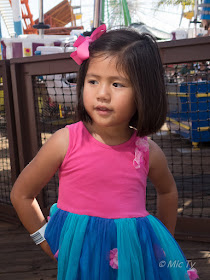Last Sunday, we went to Santa Monica's Pacific Park, a small amusement park at the famous Santa Monica pier. I took some shots Strobist-style (i.e. with off-camera flash). In this post, I would like to share some samples comparing on-camera flash, off-camera flash, and no flash.
For my camera, I used the Olympus Stylus 1. Besides being versatile, it also has unlimited sync speed, which made the flash more efficient. The Stylus 1 also has a popup flash that can control a compatible speedlight wirelessly.
For my flash, I used the Olympus FL-36R, a small yet full-featured speedlight compatible with Olympus' RC wireless system (note: Olympus' system is optical, not radio-controlled, despite the name). Because the FL-36R only has modest power, I chose to use it bare, with no modifiers. To make the light more interesting, I mounted the flash on a selfie-stick (using the FL-36R's included flash stand), which enabled me to have much more control over its direction, compared to using it handheld.
The selfie stick I used was the iKross selfie stick, which has an adjustable head with 1/4-20 mount and can convert from a selfie stick to a tripod (technically, a chicken-foot style self-standing monopod). However, on this occasion, I used it only as a monopod and not a tripod.
OFF-CAMERA FLASH
I had never used the Olympus wireless flash system outdoors, much less in very bright sun, so I wasn't sure if it would even work. I didn't know how sensitive the wireless flash sensor was, nor did I know if the popup commander would be able to put out enough light for the flash to detect its signal. I first tried it indoors. With the flash held about 3 feet above and to the right of the camera, the flash triggered successfully, even though the flash was not in the direct line of sight of the popup commander flash. It appears that the FL-36R's sensor can detect the popup flash reflected from the subjects (similar to Nikon's CLS AWL flashes). I also tried putting the light in other directions, and it triggered consistently.
Outdoors, in very bright sun, it was less consistent. Sometimes, it would work (note here that the flash is from above and slightly to the left of the camera, while the sunlight was behind the subjects, to camera right).
At other times, it wouldn't detect the commanding signals from the Stylus 1, which wasn't very surprising because of the Stylus 1's small popup flash. There were also times when the flash would detect the signal, but for some reason, the flash exposure would be too bright.
 |
| correct exposure |
 |
| nuked |
Anyway, here are some shots to compare with and without flash:
 |
| flash didn't trigger - I used dodging and burning to bring up the subjects' exposure. |
 |
| similar shot where the flash was triggered |
In the first shot below, I used Lightroom's radial gradient to bring up the subject's exposure. In the shot below it, I used flash.
Here are some more samples with off-camera flash:
ON-CAMERA FLASH
Sometimes, I switched to using the flash on-camera as fill, such as when my kids were too far away, in which case it would not be practical to position the flash at a desirable angle, and I'm better off using the flash as on-axis fill light.
Here are some shots with on-camera flash:
EPILOGUE
I hope these shots illustrate the differences between off-camera flash, on-camera flash, and no flash. I'm not trying to imply any one of them is the best. In my opinion, there is no single technique that is always superior. The best technique to use depends on the circumstances and the photographer's intent.
 |
| No flash |
 |
| With flash (on-camera as fill light) |
Here is a comparison between on-camera flash and off-camera flash:
 |
| on-camera flash |
 |
| off-camera flash |
I hope these shots illustrate the differences between off-camera flash, on-camera flash, and no flash. I'm not trying to imply any one of them is the best. In my opinion, there is no single technique that is always superior. The best technique to use depends on the circumstances and the photographer's intent.













No comments:
Post a Comment
Thanks for your comment. It will be published as soon as we get a chance to review it, sorry for that, but we get lots of spam with malicious links.